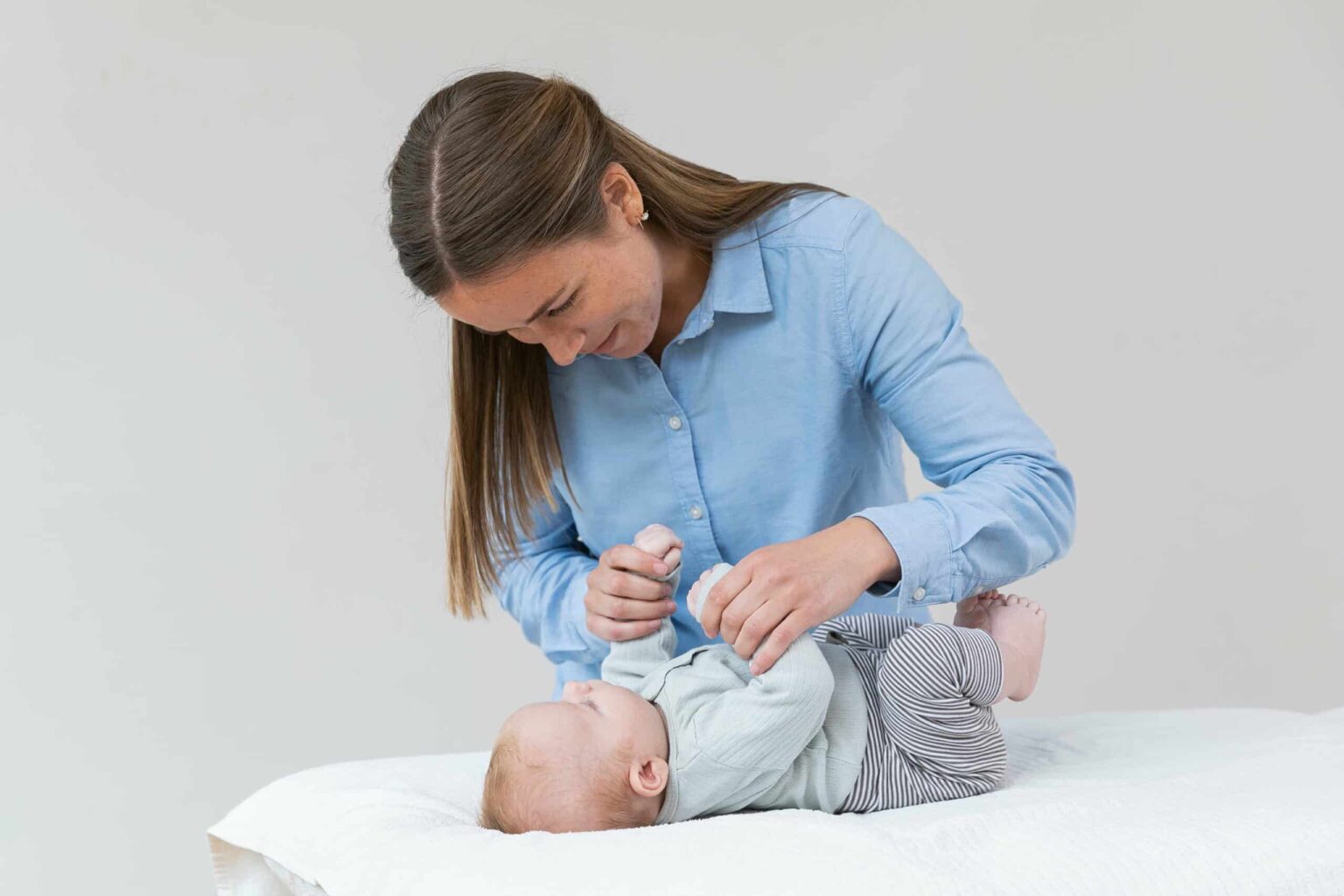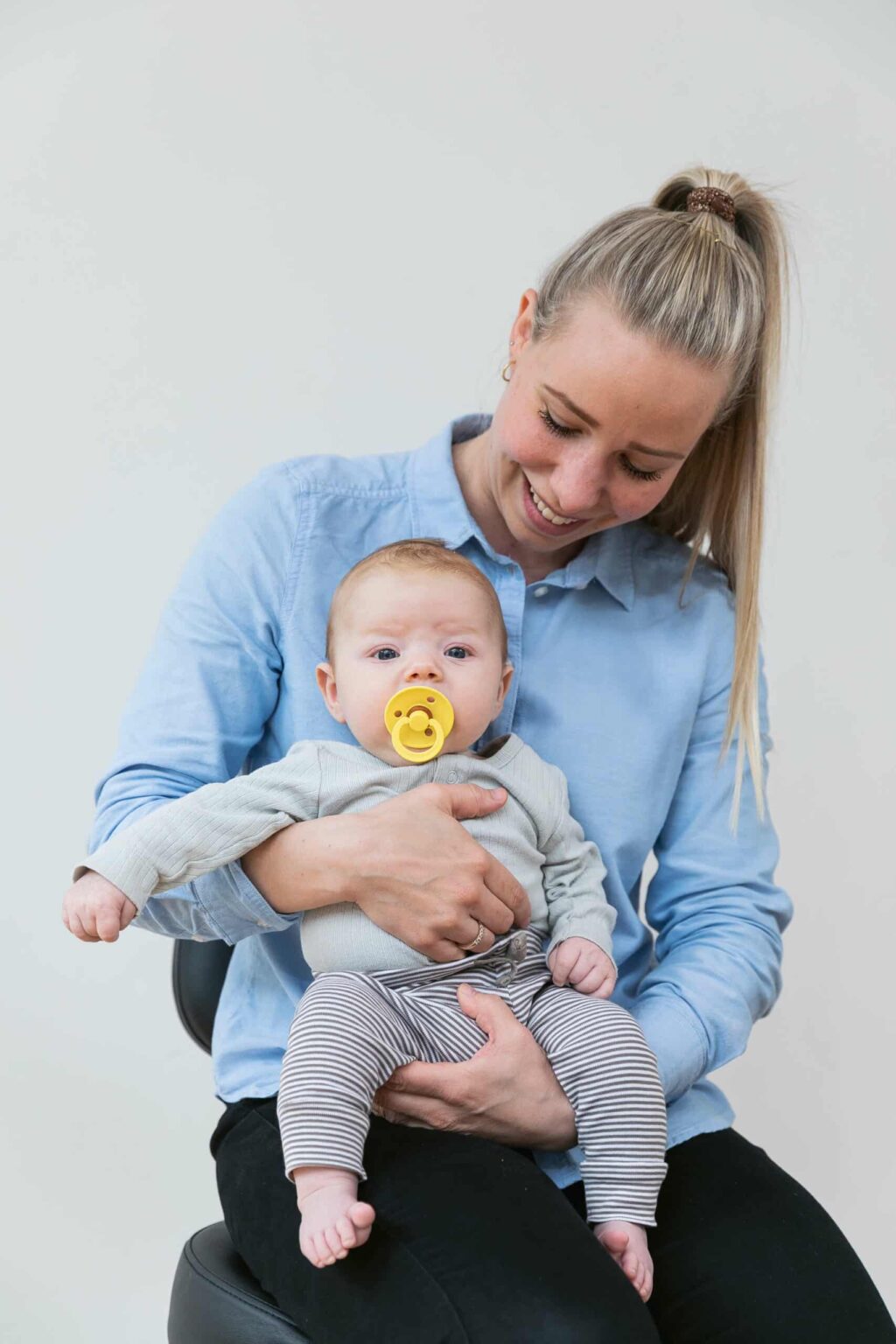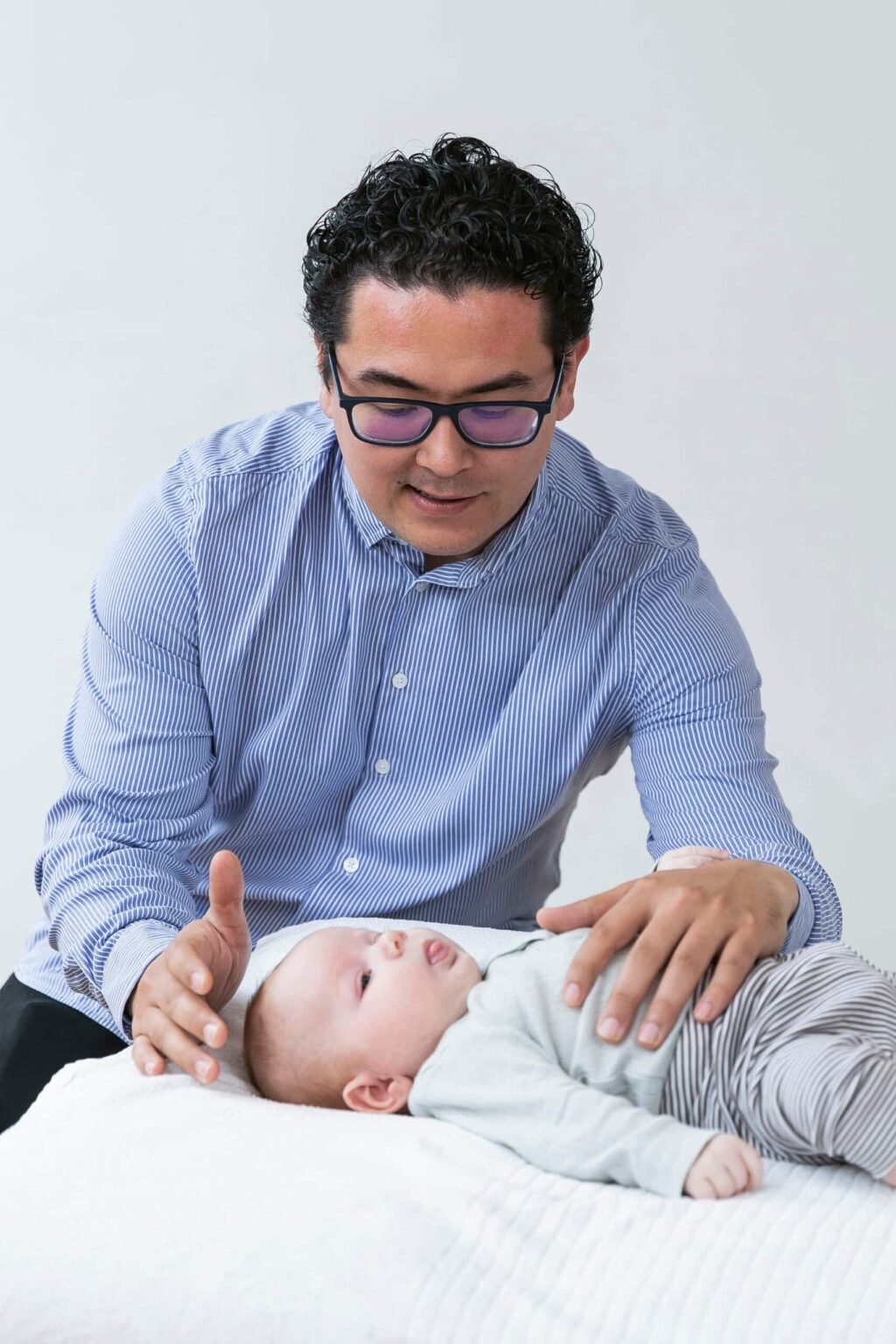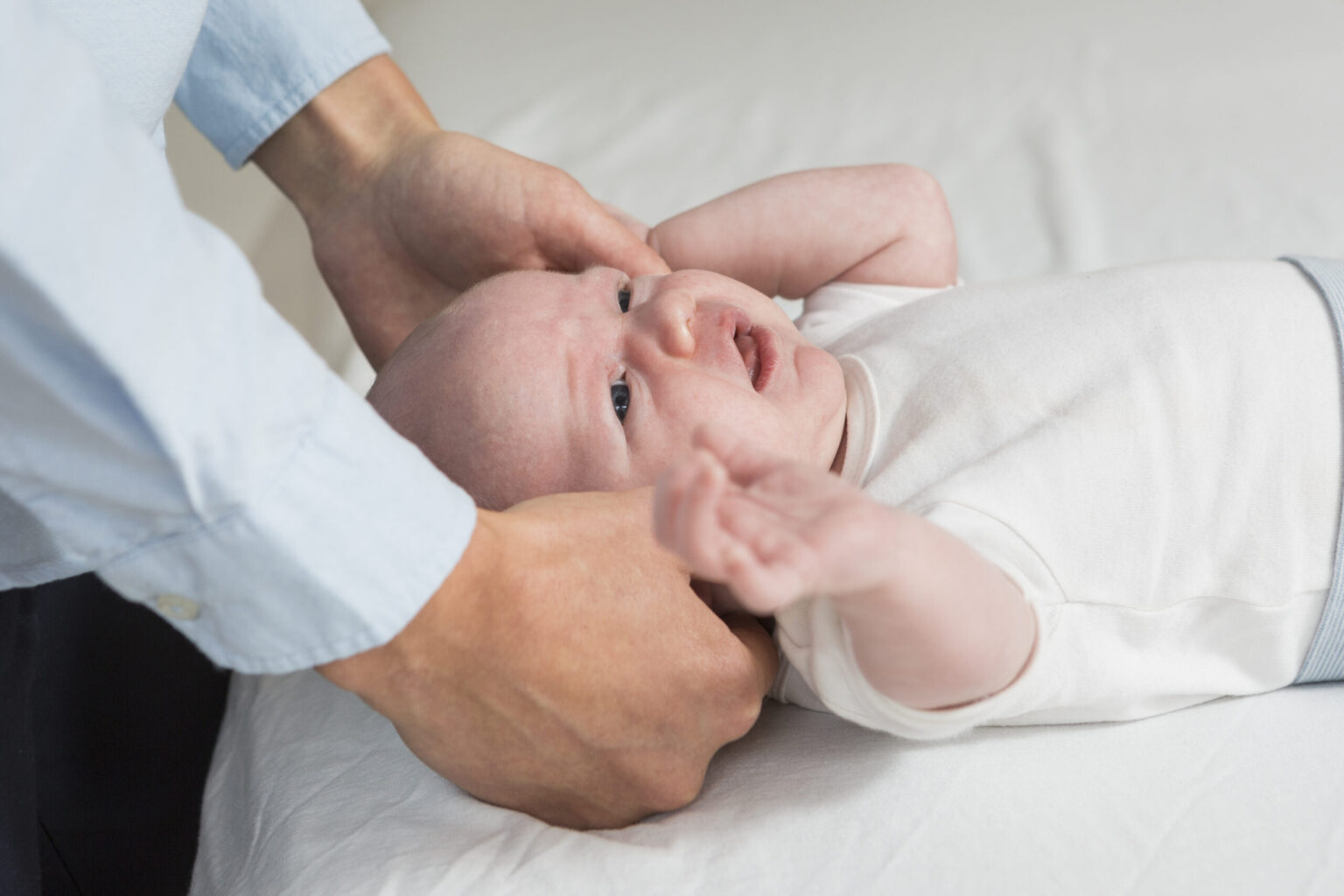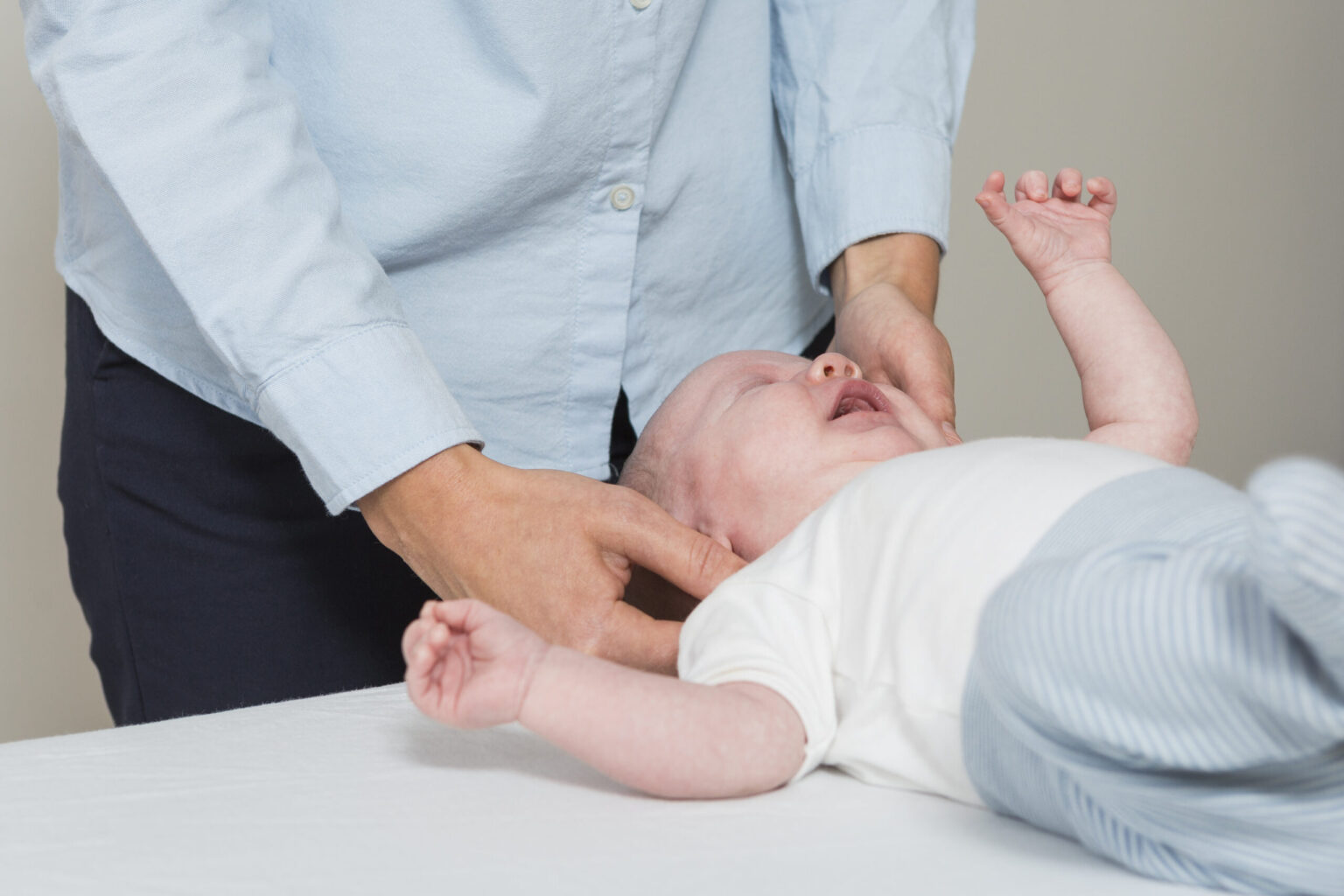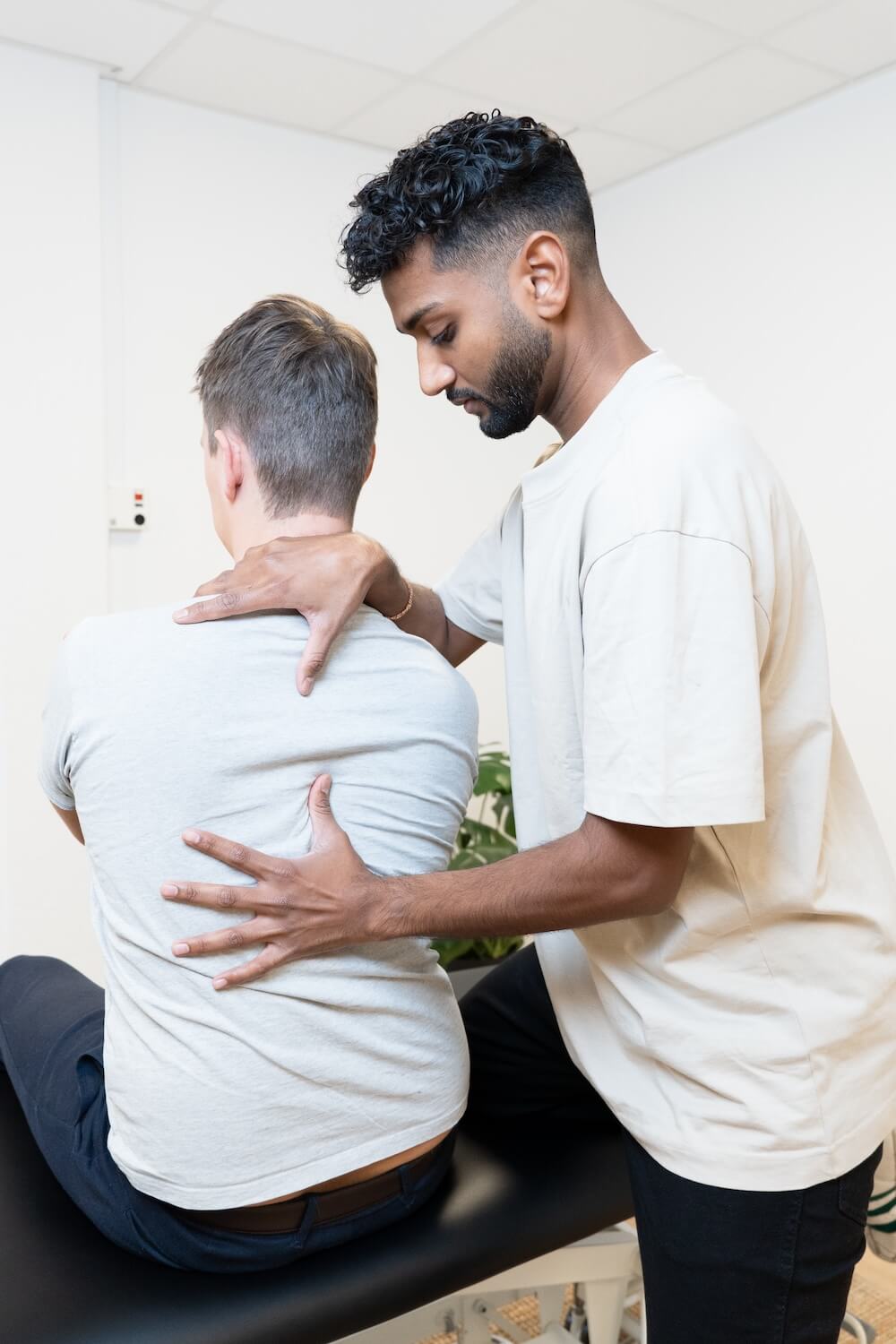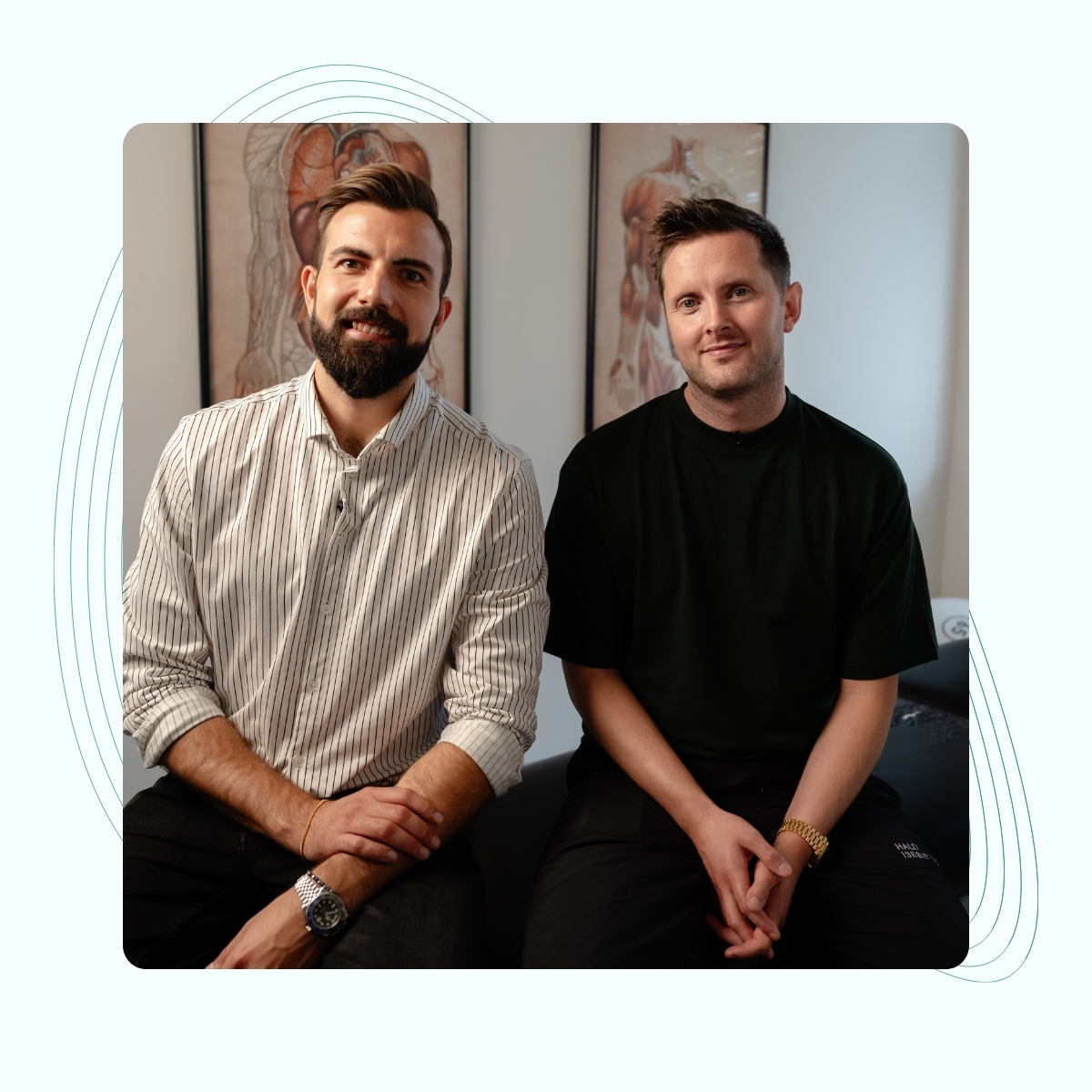We offer gentle osteopathic support for
Torticollis
Learn more about torticollis and how osteopaths can support your baby’s comfort
What is Torticollis?
Torticollis is a term used to describe a situation where a baby’s head tilts to one side while turning towards the opposite side. This pattern is often linked to how one of the neck muscles, the sternocleidomastoid, is working or adapting. When this muscle feels tighter or more active on one side, it may influence the baby’s preferred head position.
For example, if the right side of the neck feels tighter, the baby may rest the right ear closer to the right shoulder while naturally looking more towards the left. Parents often notice this as a consistent “favourite side,” where the baby prefers to turn or rest the head in one direction more than the other.
These patterns can have many possible influences, including position in the womb, birth experience or early movement habits. An osteopath can gently assess how the baby moves and offer soft, calming support to encourage comfort and ease of movement.
Jump to section [Vis]

Types of Torticollis
The term torticollis can describe several different head-turning or head-tilting patterns in babies. These patterns can appear for many different reasons, including how the baby was positioned in the womb, the birth experience, or early movement habits.
Health professionals often refer to two broad categories when describing these patterns:
-
Congenital torticollis, where the preference is present from birth
-
Functional torticollis, where a head-turning pattern develops over time as the baby adapts to certain positions or movements
These descriptions simply help explain the different ways torticollis can appear. An osteopath can gently assess how your baby moves and explore what may be influencing their preferred head position.
Congenital muscular torticollis (CMT)
Congenital muscular torticollis is a term used when a baby shows a clear head-tilt and rotation pattern from birth. This may be influenced by how the baby was positioned in the womb, the way the birth unfolded, or how the neck muscles adapted during these early stages.
In some births, the baby may have experienced limited space or increased pressure on the head or neck, such as during a longer labour, a quicker birth, or an assisted delivery. These situations may influence how one of the neck muscles, the sternocleidomastoid, adapts, occasionally leading to a small area of firmness or swelling in the muscle. Parents sometimes describe feeling a small “pea-sized” nodule in the neck, which typically softens over time as the tissue settles.
Position in the womb may also play a role. Babies who spent long periods in one position. For example with limited space around the head and neck or in a breech position – may show a stronger preference for a particular head direction after birth.
Some families also notice that head-tilt patterns can run in the family, suggesting that natural anatomical or postural tendencies may play a part.
Babies with congenital torticollis often show a consistent “favourite side,” tilting the head towards one shoulder and turning to the opposite side. This can make it more difficult for them to turn fully in the other direction, both actively and passively.
An osteopath can gently assess how your baby moves and explore what may be influencing this early head-turning pattern.

Functional torticollis (postural torticollis)
Functional or postural torticollis is a term used when a baby develops a head-tilt or head-turning preference in the days or weeks after birth. This pattern may be influenced by similar factors as congenital torticollis – such as position in the womb, early movement habits or how the baby prefers to rest.
The presentation is often milder than congenital forms. Parents may notice increased tightness or activity in one side of the neck rather than noticeable swelling. The baby may still be able to turn the head towards the less-preferred side, but often with less ease. This is commonly described as a “favourite side.”
If parents are unaware of a developing head-turning preference, the baby may spend more time resting on one area at the back of the head. This may contribute to a flatter appearance on one side over time, simply due to how pressure is distributed when lying on the back.
An osteopath can gently explore your baby’s movement patterns, comfort and symmetry, and offer calm, supportive guidance for encouraging a broader range of motion.
Other causes of a sudden neck tilt that parents should be aware of
A sudden change in a baby’s head or neck position can occasionally be linked to factors unrelated to muscle tension. These may include:
- A fall, impact or other form of trauma
- Discomfort related to the collarbone, especially if there was strain during birth
- Difficulties with vision or hearing
- Signs of infection, fever or general illness
- Unusual lumps or areas of firmness in the neck
- Concerns about how the bones of the neck or skull are developing
If a baby develops an acute head-tilt together with any of the above signs, parents should contact a doctor or healthcare professional for assessment and guidance.

Signs parents may notice in babies with a head-turning preference
Parents often observe patterns that may indicate a strong head-tilt or head-turning preference in their baby. These can include:
- A resting position where the ear tilts towards one shoulder while the head turns to the opposite side
- A small, firm area in the side of the neck that feels like a pea when touched
- Reduced ease of turning the head equally to both sides
- Challenges with latching or feeding comfortably on one breast
- Appearing unsettled or crying more when lying in certain positions
- Sensitivity or discomfort when the neck area is touched
- One shoulder appearing slightly higher than the other
- A flatter appearance on one side at the back of the head
- A gentle C-shaped or banana-shaped curve through the body when lying on the back or tummy
These observations can have many possible explanations. An osteopath can gently explore how your baby moves and provide calm, supportive guidance tailored to your baby’s comfort and development.
How a head-turning preference may influence early motor development
A consistent head-tilt or head-turning preference can sometimes influence how babies use their eyes, body and balance systems during early development. The visual system works closely with the inner ear and the body’s sense of position to help a baby coordinate movements such as rolling, sitting and eventually standing.
When a baby prefers to turn the head mainly to one side, their visual field and balance responses may be explored more often from that direction. Over time, this can gently shape how they use their body. For example, reaching more with one hand, rolling more easily to one side, or favouring certain positions during play.
These natural adaptations can occasionally make some movements, such as crossing midline or using both sides of the body equally, feel less familiar or take longer to develop. Babies are highly adaptable, and many will find their own creative movement solutions, though they may explore some skills differently or at a different pace.
Osteopaths take these factors into account and can gently support parents in encouraging a broader range of movement and comfort during everyday play and interaction.

Osteopathic support for babies with a head-turning preference
Osteopathic sessions for babies begin with a gentle assessment of the whole body. This helps the osteopath understand where areas of tension or reduced ease of movement may be influencing the baby’s comfort or preferred head position.
When working with infants, osteopaths use very soft techniques aimed at supporting relaxation and encouraging free, comfortable movement of the neck, head and upper body. These approaches are calming, slow and always adapted to the baby’s needs.
Sessions often focus on the neck, jaw, shoulders and upper chest, as these areas can play a role in how babies turn and hold their heads. The osteopath will also consider how the muscles and connective tissue around the spine and rib cage are working together, especially if the baby shows a gentle C-shape or banana-shape posture when lying down.
Throughout the process, the aim is to create comfort, relaxation and ease of movement, helping the baby explore a broader range of positions during everyday play.
Play and movement ideas at home
Parents play an important role in supporting symmetrical movement. Your osteopath may suggest simple ideas you can use at home – such as positioning, gentle stretches through play, or activities that encourage your baby to look or reach in different directions.
These suggestions are designed to fit naturally into daily routines, making it easier for your baby to explore both sides of the body with confidence.
It’s helpful to remember that changes can take time. Babies develop at different paces, and a head-turning preference may settle gradually as the baby gains comfort and a wider range of movement.
What can you do at home?
There are many simple ways parents can help encourage their baby to explore different movements and head positions during everyday routines.
A good place to start is by looking at the setup of your home. Small adjustments can make a big difference. For example, consider where your changing table is placed in relation to windows, light and interesting objects. If your baby tends to look more towards the brighter or more stimulating side, you can gently reduce distractions there and introduce more visual interest on the less-preferred side. This can be done with the position of toys, colours or even where you stand when interacting with your baby.
You may also find it helpful to:
- Sit, talk or play from the less-preferred side to encourage your baby to turn in that direction
- Offer plenty of varied positions throughout the day, such as tummy time, side-lying and supported sitting
- Use play and eye contact to gently motivate your baby to look in different directions
Your osteopath can guide you with personalised, safe and age-appropriate ideas for home play and positioning.
Contact us here if you would like to learn more about how we can support you and your baby

